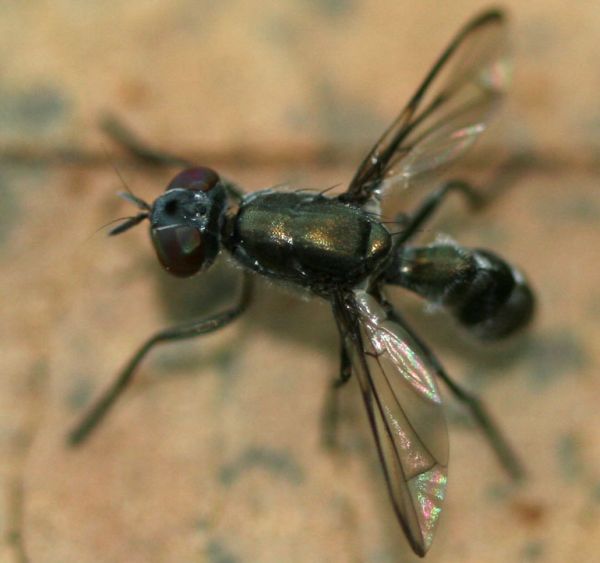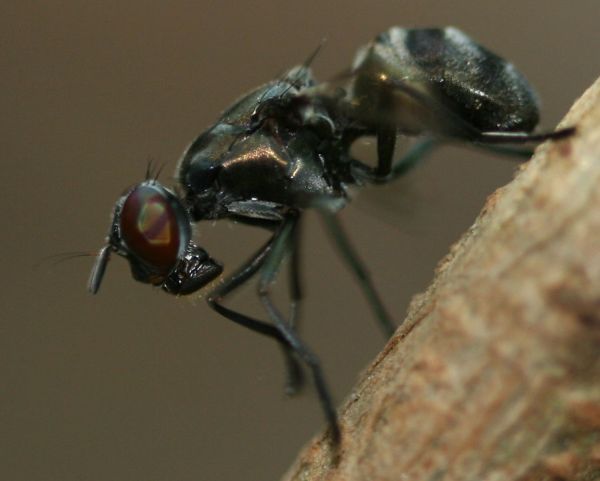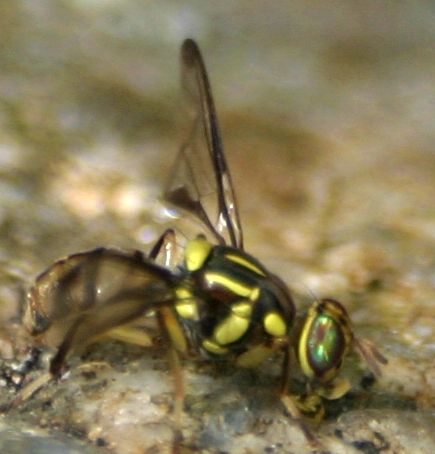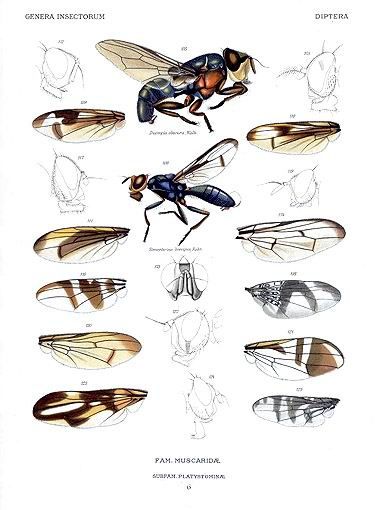Thread subject: Diptera.info :: Thai20. A fly.
Posted by Nikita Vikhrev on 13-01-2006 12:40
#1
Widespread in secondary vegetation near decaying organic. Look and act as very large (7-10mm) Sepsidae.
I wouldn't be very much astonished if it is some crazy Muscidae.

Edited by Paul Beuk on 23-11-2006 14:36
Posted by Paul Beuk on 13-01-2006 13:26
#2
Interesting. Reminds me of Tanypezidae but will 'think further'. ;)
Posted by Nikita Vikhrev on 14-01-2006 12:53
#3
Another vue of same fly.

Edited by Paul Beuk on 23-11-2006 14:37
Posted by Nikita Vikhrev on 15-01-2006 12:30
#4
I met another fly from same family (I think). May be it helps.


Posted by John Smit on 16-01-2006 09:50
#5
Dear Nikita,
Tha last two photo's are not the same Family!
The yellow and black species is a Tephritid, genus Dacus or Bactrocera, depending on whether you follow the splitters who devide the genus Dacus into several (sub)genera.
I think that the first fly is either a Sepsidae or a Ulidiidae.
John
Edited by John Smit on 17-01-2006 09:05
Posted by Nikita Vikhrev on 17-01-2006 07:33
#6
Thank you John. Never image that Tephritidae may look like this!
Nikita
Posted by Nikita Vikhrev on 07-02-2006 10:17
#7
I've got assumption about it from Andrey Ozerov that it may be Megamerinidae.
According Ausnralian checklist:
Megamerinidae are an enigmatic family comprising about 11 species in the genera Gobrya Walker, Megamerina Rondani, and Texara Walker. Syringogaster Cresson, formerly placed in this family, has been placed in its own family, Syringogastridae (Prado 1969), which is apparently an endemic Neotropical family. The immature biology of Megamerinidae is poorly known, but larvae have been recorded as living under bark or decaying vegetation.
Gobrya, the only representative in the Australasian/Oceanian Regions, is primarily Oriental with an eastern extension into the Papuan Subregion. Colless & McAlpine (1970: 722) stated that Gobrya is erroneously referred to this family, but do not offer an alternative. McAlpine (1982b) ascribes it to the Nothybidae and Ferrar (1987) treats it in the Syringogastridae. Until further phylogenetic studies are done to clarify its family placement, I follow Steyskal (1977b) in placing it within the Megamerinidae.
Nikita
Posted by Susan R Walter on 07-02-2006 14:06
#8
Nikita - is the Australian Checklist you often quote available as a download off the web? You have obviously found it v useful, and I am off to central Australia in April. (I am, in fact, Australian born, but have lived in England for the last 10 years. When in Australia, I concentrated on butterflies, so know shamefully little about Australian diptera. It was only once I was in England and looking for something with a challenging degree of species diversity that I hit upon flies).
Posted by Susan R Walter on 07-02-2006 14:24
#10
Thank you - that's my holiday reading sorted then. With any luck I will completely freak out the poor stranger who gets to sit next to me on the plane.
Posted by Paul Beuk on 07-02-2006 14:28
#11
Don't worry. I was on the train many years back and we were with three dipterists and a 'stranger' in one compartment. We discussed the identification of lies and the word 'genitalia' was mentioned very often. We got a lot of funny looks and grins, but we were not arrested. :D
Posted by Xespok on 07-02-2006 18:19
#12
Nikita,
Though I am not an expert, I have doubts about the first fly being a Megamerinid fly. My gut feeling is Platystomatidae. Megamerinid flys in theory should really more resemble Micropezid flies in structure.
[url=
http://xespok.net/gallery/Megamerinidae]4 images of a species of Megamerinidae from Japan[/url]
Posted by Maddin on 07-02-2006 19:56
#13
Nikita,
I agree withXespok, it really looks like a Platystomatidae and it is for sure not a Megamerinid. They have swollen hind femora and a more elongate abdomen...
Cheers
Martin
Posted by Paul Beuk on 07-02-2006 20:16
#14
In the description of the Platystomatidae in
The families of Diptera of the Malay Archipelago by Pjotr Oosterbroek I have not seen anything that would really contradict Platystomatidae.
Posted by Nikita Vikhrev on 07-02-2006 20:27
#15
Well, I'm only in position to listen.
Anyway, I'm sure that correct ID will be finded, fly is collected and fly is rather common in very antropogenic places.
Thank you all, Nikita.
Posted by Nikita Vikhrev on 22-02-2006 13:33
#16
Andrey Ozerov just told my that he has another idea concerning this fly - Platystomatidae.
This time it seems that it is the final answer.
I've found on http://bugguide.net/node/view/11999/bgpage Rivellia sp. identified by Paul himself.
Same family, if not same genus, doesn't it?
Posted by Paul Beuk on 22-02-2006 13:45
#17
Quite well possible, but I do not know the Oriental
Rivellia. The ones I have seen (Holarctic) all had bands on the wing (like the onon bugguide) but the Oriental may be different. And... I had not realised that the mouthparts of those Nearctic ones were that big, too!
Posted by Xespok on 23-02-2006 09:02
#18
This fly does not look like a Rivellia to me, but I have no idea what extent of morphological variation this genus harbors. It does not look like any of the Rivellia species that I had seen in Japan.
Edited by Xespok on 23-02-2006 09:02
Posted by Nikita Vikhrev on 23-02-2006 10:46
#19
Hi Xespok.
Between your images collection it reminds Lamprophthalma. Diptera of Far East key also lead to this genus (shape, size - 8-9mm, bm-cu direction) with 10 sp. in Paleotropics. The only species in my key is L. japonica which is not the case obviosly.
As for Rivellia, even in Russia Far East about ten species (found or possibly found). Size is OK (2-4mm), about species level Paul was right - difficult to say something.
Posted by Nikita Vikhrev on 27-02-2006 00:04
#20
Today I found image of same (I hope so) fly. Unfortunely I can't red the name of genera:(

Posted by Nikita Vikhrev on 23-11-2006 08:00
#21
I think that I know the genus now - Elassogaster sp. (at least, there are 2 spp.) - R4+5 and M1+2 is near at wing apex.
Nikita
Posted by Nikita Vikhrev on 23-11-2006 16:18
#22
Thank you for images reparation, Paul.
But I bring one more image from this trip and add it too.




